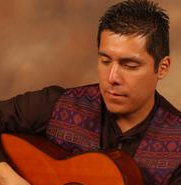
Cesar Paucar
César Páucar is a Peruvian guitarist whose musical stylings range from classical to flamenco, from Latin to folk. Although his roots are in Peruvian guitar music, Cesar’s compositions encompass the many rhythms and sounds he grew up listening to, a musical mix as eclectic as the term “world music” has come to be known.
He began performing during his teens as a flamenco guitarist in Peru, accompanying singers and dancers in Peruvian tablaos. At the same time, he studied Andean guitar with renowned guitarist Raúl García Zárate and the many guitar rhythms and themes of coastal Peru with Félix Casaverde.
César left Perú in 1992 to attend Florida Atlantic University where he received Bachelors and Masters degrees in Latin American Literature. He has performed all across South Florida as a solo guitarist and worked with Latin guitar duo Strunz and Farah on transcriptions of their music. Recently, he performs off and on with Latin Grammy nominee Damaris and her mother Saywa, two of Peru's most notable artists.
César has three solo recordings available: 2002’s “Rumbos Rítmicos” (Rhythm Roads) which showcases a variety of rhythms from coastal Peru and the Andes mountains, and 2003’s “Palahia Street” with rhythms from all of Latin America.
He is a requested guitarist for the Regent Seven Seas Cruise line of passenger ships, having performed on the RSSC Voyager in the fall of 2005 and the fall of 2006 and the RSSC Mariner in the spring of 2007.
César's third solo outing is entitled "De amanecida" (At Dawn's Door), consisting of Peruvian music with the collaboration of several renowned Peruvian artists’ such as Julio Tirado, Saywa, Lourdes Cárhuaz, and Rosa Guzmán. Also included will be the guitar duet “Cachondeo” written by flamenco guitarist and friend Errol Putigna featuring percussion by David Schanzer.
For live performances, César brings a latin-jazz approach to Peruvian music, frequently performing with a looper, an effects device used by such greats as Phil Keaggy and Jaco Pastorious. It is César's intention to “bring Peru’s music to a broader audience by making it accessible not only as traditional folk music, but also as a fusion with other great instruments and rhythms found in other cultures.”